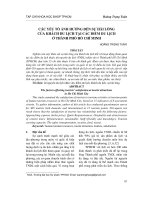Các yếu tố ảnh hưởng đến sự hài lòng của khách hàng doanh nghiệp với dịch vụ tín dụng của các ngân hàng thương mại tại tỉnh Thái Nguyên (1)
Bạn đang xem bản rút gọn của tài liệu. Xem và tải ngay bản đầy đủ của tài liệu tại đây (220.77 KB, 23 trang )
FACTORS AFFECTING ENTERPRISE CUSTOMERS’ SATISFACTION
OF CREDIT SERVICES PROVIDED BY COMMERCIAL BANKS
IN THAINGUYEN PROVINCE
EXECUTIVE SUMMARY
CENTRAL PHILIPPINE UNIVERSITY
DOCTOR IN BUSINESS ADMINISTRATION
NGO THUY HA
OCTOBER 2016
1
EXECUTIVE SUMMARY
Factors affecting enterprise customers’ satisfaction of credit services
Title:
provided by commercial banks in Thai Nguyen province
Total No of Pages:
105
Researcher:
Ngo Thuy Ha
Degeree Program:
Doctor in Business administration
Institution:
Central Philippine University Jaro, Iloilo City, Region VI
RATIONALE/INTRODUCTION OF STUDY
Customer is one of the critical factors to the existence and development of organizations
in general and banks in particular. Therefore, to develop sustainably in long term banks need
to attract more customers. In the current period, the banking industry is facing a market that is
rapidly changing; new technologies are being introduced; there is fear of economic
uncertainties, fierce competition, more demanding customers and the changing climate have
presented an unparalleled set of challenges (Lovelock, 2008). It requires banks to find
solutions to attract, retain customers and especially to make good relationship with loyal
customers groups; this problem is considered to be one of the key tasks to create long-term
competitive advantage for the banks. To gain this achievement, banks must understand
consumer behaviors, especially the factors that affect their satisfaction with the banking
services they utilize.
Customer satisfaction is influenced by customers’ perceptions of quality (Zeithaml and
Bitner, 2000). Service quality is an antecedent of the broader concept of customer satisfaction
(Gotlieb et al., 1994; Buttle, 1996; Zeithaml and Bitner, 1996; Lee et al., 2000). The European
and American customer satisfaction indices models, however, suggest that service quality is a
component of satisfaction (Fornell et al., 1996). Firms that provide superior service quality
also have a more satisfied customer base (Gilbert et al., 2004; Gilbert and Veloutsou, 2006).
2
A lot of researches in the world as well as in Vietnam suggest that providing an
impeccable customer service has become the factors that make the difference, which is
regarded as an important weapon in meeting customer demand, creating satisfaction and
loyalty of customers with suppliers (Oliver, 1993; Anderson and Sullivan, 1993; Fornell et al,
1996; Zeithaml et al., 2006; Wilson et al., 2008); this is the basis of the competitive advantage
that all organizations or businesses want to have ownership.
In banking business, Titko and Lace (2010) accentuate that the competitive power and
survival of a bank lies in the degree of its customer satisfaction. Banks therefore pay particular
attention to customer satisfaction (Kattack and Rehman, 2010). According to Stafford (1996),
due to the fact that banks sell undifferentiated products, the only effective tool they can use to
survive in the market is the quality of service. Bowen and Hedges (1993) claim that banks that
offer very high quality services have a competitive advantage because the benefits of
improving service quality are large market shares increased in profits and increased in
customer retention. In addition, Zeithmal et al (1996) submits that the reputation of the banks
is enhanced, new customers are captured and there is an increase in financial performance.
Yeung et al (2002) on the other hand intimate that customers bring new customers to the bank
through word-of-mouth and thereby reducing the cost of marketing.
Banks normally divide their customers into individual and corporate (enterprises) ones.
Satisfaction with the policy of commercial banks regarding small and medium enterprises
(SMEs) is one of the most important factors affecting the success of commercial banking
activities (Adamonienė and Trifonova, 2007; Madill et al., 2002; Viktorija Skvarciany, 2014).
These studies identify and investigate the factors influencing satisfaction of small and
medium-sized enterprises with the policy of commercial banks concerning SMEs, i.e.,
granting of loans corresponding business needs, offering appropriate financial services to
business, creating favorable loan conditions, flexible response to changing business needs,
3
business support by a bank during successful company activities period, business support by a
bank in the critical moments of company activities, making timely financing decisions.
In Vietnam, there are not many studies about customer satisfaction, especially about
bank customers. These are made with customers of some specific banks. So the application of
these studies’ results have been limited (Le Xuan Huy, 2007; Hoang Xuan Bich Loan, 2008;
Ha Khanh Nam Giao, 2011).
In 2010, ThaiNguyen city was recognized as a first class city of Vietnam, whereby, the
economic and social development in general and the services industry, especially banking
services in particular in Thai Nguyen had made a very important progress. Up to the time of
August 2015, there have been 18 commercial banks (see APPENDIX 1) setting up branches in
Thai Nguyen; the system of commercial banks has important contributions in promoting the
socio-economic development of Thai Nguyen province. Among them, some of the banks have
organized business activities in long time such as: Bank of Agriculture and Rural Development
(Agribank), Vietnam Industrial and Commercial Bank (Vietinbank), Bank for Investment and
Development (BIDV), The Bank for Foreign Trade of Vietnam (Vietcombank); some other
banks have less uptime in Thai Nguyen; these banks are new enters markets of the Thai
Nguyen province, and they face difficulties in reaching and attracting customers as well as
competing with the leading banks groups.
In Thai Nguyen province, organizational customers are often small and medium
enterprises which have big loan demands to serve production and business activities.
Currently, the number of enterprises which are registered business in Thai Nguyen province is
about 2,000. These customers group has big number of transactions and the capital
transactions accounted for most of the total capital transactions of the bank.
Wishing to help the commercial banks system in Thai Nguyen province understand the
factors affecting satisfaction of the enterprises customers when using the credits services of
the bank, thereby building development policies, marketing policies, customer service
4
processes which have better quality to attract and retain customers, especially loyal customer
groups, the author chose the topic “Factors affecting enterprise customers’ satisfaction of
credit services provided by commercial banks in Thai Nguyen province” as research title.
OBJECTIVES
General
The general objective of the research is to evaluate, measure the level of satisfaction of
the enterprises customers group using credits services of commercial banks in Thai Nguyen
province, analyze factors affecting customer satisfaction for the service that the bank had
provided, and then propose solutions to further improve the customer satisfaction.
Specific
To be able to accomplish the research objectives of the thesis, the researcher will carry
out the specific objectives as follows:
1. Systematizing the theories on factors that affect satisfaction of customers who used
bank credit services.
2. Constructing research framework to assess satisfaction, and the factors that affect
customer satisfaction towards credit services offered by the Banks.
3. Analyzing factors affecting satisfaction of enterprises group using credit services
from commercial banks in Thai Nguyen provinces.
4. Measuring the satisfaction level of enterprises customers group who used credit
services from old and new commercial banks in Thai Nguyen province and compare the
advantages of old and new commercial banks.
5. Comparing the factors affecting satisfaction of small, medium and large enterprises
with bank credit services to show which strategies are suitable with each enterprise groups.
6. Proposing solutions to improve customer satisfaction which are the basis to plan
overall business strategy in the short and long term, marketing strategy to penetrate deeply
into the market, the process of providing services, and customer relationship management.
5
RESEARCH HYPOTHESES
In view of analyzing the enterprises’ satisfaction with the credit services of commercial
banks in Thai Nguyen province, the following hypotheses would be tested:
1. There is a positive relationship between Image and enterprises’ satisfaction with bank
credit services of commercial banks.
2. There is a positive relationship between Utility and enterprises’ satisfaction with bank
credit services of commercial banks.
3. There is a positive relationship between Empathy and enterprises’ satisfaction with
bank credit services of commercial banks.
4. There is a positive relationship between Assurance and enterprises’ satisfaction with
bank credit services of commercial banks.
5. There is a positive relationship between Buying situation and enterprises’ satisfaction
with bank credit services of commercial banks.
6. There is a positive relationship between Price and enterprises’ satisfaction with bank
credit services of commercial banks.
7. There are differences in assessing the satisfaction of enterprises with bank credit
services of old and new bank group.
8. There are differences in assessing the satisfaction of small, medium and large
enterprises with bank credit services.
9. There are differences in assessing the satisfaction of staff in different position in
enterprises with bank credit services.
RESEARCH DESIGN AND PROCEDURE
To choose suitable variable and good scales for the model to measure the satisfaction of
enterprise, after literature review by desk research method, author continues carrying out a
qualitative research with using depth interview with specialists to delete unsuitable variables.
6
Then the questionnaire is prepared and tested in pilot survey to check if the scales and
questions are reasonable.
POPULATION AND SAMPLE RESPONDENTS
Population
The target population of this study was the acting enterprises which use credit services
of commercial Banks in ThaiNguyen province.
But as many experts in both Banking sector and enterprise, most of enterprises in
Thainguyen province use credit services to gain better capital resources for business and there
isn’t any statistic number about the real population. Therefore, author will use the number of
all enterprises in Thainguyen as population size. This number can ensure that it is bigger than
the real population size, and the results from sampling method of this population size are still
good. According to ThaiNguyen Statistics office, up to 2014, there are 2090 enterprises in
ThaiNguyen province.
Sample respondents
Because buying credit service in enterprises often relates to managers, accountancies
and project staff so the sample respondents will be chosen from these people whom works
relates to banks’ credit services in the chosen enterprises.
SAMPLING TECHNIQUE
Due to the difficulty of access to enterprises, especially in requirement for the data
relating to the business situation, so author used conveniently selecting sample method based
on acquaintances in the businesses in the province.
With these experiences in choosing good sample size, author decides to use 350
questionnaires in the official survey to prevent the situation that some answer sheets of
questions have to remove because they lack of information.
7
Basing on the all relationship, author collects the name of enterprises which have been
using bank’s credit services; their legal status and size of capital; people can be respondents
for the research name, position and their contact. From 467 enterprises in this list, author tries
to choose 350 enterprises (which have type and capital size of enterprise nearest the structure
of population) as research sample.
Table 3.2: Structure of sample enterprises by type and capital
Type of enterprise
No
Capital of enterprise
No
Limited Co.
149
Below 500 million VND
31
Joint stock Co.
101
From 500 million to 1 billion VND
73
2
From 1 to 10 billion VND
185
97
From 10 to 50 billion VND
42
1
From 50 to 200 billion VND
12
From 200 to 500 billion VND
3
Upper 500 billon
4
State owner
enterprises
Private
100% foreign capital
enterprise
Sample respondents are chosen randomly from these people whom works relates to
banks’ credit services in the chosen enterprises in the list.
DATA GETHERING AND INSTRUMENTS
The study used the questionnaire as the instrument of the study. There are 5 main parts
in the questionnaire.
The first part of the questionnaire gathers information about the personal profile of the
respondents including: gender, position in organization.
The second part gathers information about the organization profile including: types of
enterprise, business area, the capital scale, time experience in business.
8
The third part gathers information about organization annual activities including: annual
business capital, annual revenue, annual cost and annual transaction with banking.
The fourth part gathers information about credit service that enterprises used in
commercial banks and their satisfaction with these services. The total satisfaction is placed
before the partial satisfaction questions because customers, by answering the overall
satisfaction question firstly, have the ability to interpret the meaning of this question and
―naturally‖ give their judgment.
The fifth part gathers information about the important of factor influencing on the
satisfaction of enterprises with credit services of commercial banks.
Finally part gathers information about the feedback of customers to bank to improve the
credit services’ quality to enhance the customers’ satisfaction.
Five more data collectors were hired and trained to gather information for the study.
They were trained to ask the right questions and to avoid leading questions. The survey was
carried out in the period from April 15 to May 30, 2016.
DATA PROCESSING AND ANALYSIS
Data processing
Secondary data: The researcher will aggregate, classify and arrange the information
collected by each group consistent with content of research.
Primary information: Excel 2007 and SPSS 22.0 software is used to analyze the factors
that affect the satisfaction of enterprise with banking services of commercial in Thai Nguyen
provinces and the importance of them.
Information analyzing method
Descriptive statistics Methods
Comparisons Methods
Using regression analysis process:
9
Test the reliability of scales (Cronbach Alpha)
Exploratory factors analysis
Correlation analysis
Multiple Linear Regressions
RESEARCH FINDINGS
After analyzing data from the survey, author finds out some characteristics of
enterprises at Thainguyen province when they use credit services of commercial banks and
assess their satisfaction as following:
Firstly, the ratio of enterprises which have bank loan in total business capital below
20% are up to 61.2% enterprises and it’s not good situation especially with new start-up
enterprises and SMEs. Many of enterprises at Thainguyen province are SMEs and they are
hard to loan capital from bank because, as main comment in the last part of questionnaire,
lack of collateral and complex procedure are the main barriers to enterprises to approach the
bank loans.
Secondly, many enterprises have to use credit services of more than one bank at the
same time because the borrowing limit is lower than the business capital they need and if the
condition of using credit services are more suitable they really want to lend more money from
banks and other credit organization.
Thirdly, the results of regression analysis process show that all 6 initially proposed
factors of the research framework are significant to customer satisfaction. The factors
influence customer satisfaction in the order of decreasing importance as follow: Empathy,
buying situation, utility, image of bank, price, and assurance. This study’s results have the
same results from many of other studies that reviewed in chapter 1 and 2 and give more
proofs for the suitable of the research model to assess effective factors to enterprise. Some
other researches have a bit different results about the influence of ―price‖, such as Andaleeb
and Conway, 2006, when their researches proved that ―Price‖ has negative influence on
10
customer satisfaction that only because of the different ways of building concepts. This study
measures ―Price‖ following positive arrow of levels of evaluations, meaning that if evaluation
of price is better, then customers are more satisfied. Meanwhile, Andaleeb and Conway
(2006) measures ―Price‖ following negative arrow of levels of evaluations; price is considered
a barrier of using service, so it was negatively evaluated.
Fourthly, the T- test shows that there is mean difference between groups by group of
bank that enterprise most used in Thainguyen province. The trend shows that the enterprises
using the credit services of Bank in Old group are more satisfied than ones using the credit
services of Bank in New group (µ = 3.41 vs. µ = 3.18)
Fifthly, the One-Way Anova test and Tukey Post Hoc Tests also show that the Small
enterprises group is significantly different from the medium enterprises group in accessing
their satisfaction (Tukey Post Hoc Tests has p–value = 0.023 < 0.050).
And finally, the One-Way Anova test show that there isn’t mean difference between
groups by position of respondents in accessing the satisfaction with credit services of banks at
Thainguyen province.
SUMMARY OF THE RESEARCH RESULTS
The general objective of the research is to analysis of factors affecting enterprise customer
satisfaction for the service that the bank had provided when using credits services of commercial
banks in Thai Nguyen province. To accomplish the research objectives of the thesis, the
researcher carried out some specific objectives.
Firstly, systematizing the theories on factors that affect satisfaction of enterprise
customers who used bank credit services and constructing research framework to assess
satisfaction, and the factors that affect enterprises’ satisfaction towards credit services offered
by the Banks.
Secondly, analyzing factors affecting satisfaction of enterprises group using credit
services from commercial banks in Thai Nguyen provinces through regression analysis
11
process with 4 main steps: Reliability of scales (Cronbach Alpha); Exploratory factors
analysis; Correlation analysis and Multiple Linear Regressions.
According to result of Cronbach Alpha calculation, group factors in the survey are
returned in accepted values (0.900> 0.700), all individual factors have values bigger than
0.300, and the Alpha if item deleted in accordance with factor surveyed is smaller than the
group alpha synthesized, so the questions are significantly meaningful.
KMO coefficient = 0.810, ensures the requirements that 0.5
factor model explained 60.385 % of the variation of total factor. Rotation matrix result of
converging factors warrant the request of Factor loading: With 350 samples, Factor loading
samples of the elements must be greater than 0.300 (According to Hair and et al), all factor in
the model are remained after Exploratory factors analysis.
Correlation analysis results show that all variables are positively correlated with
enterprise’s satisfaction (Table 4.27). And according to Cohen (1988, pp. 79-81), Image and
Price have an average correlation with Enterprise’s satisfaction (r = 0.30 to 0.49); Utility,
Empathy, Assurance, Buying situation have an strong correlation with Enterprise’s
satisfaction (r = 0.50 to 1.00).
Multiple regression analysis by Enter method was used to test role of independent
variables in predicting the Enterprise’s satisfaction. According to Adjust R Square, the model
accounts for 52% of variable Enterprise’s satisfaction. The regression equation is formed as in
formula (1).
Total.satis = -3.009 + 0.230T.IMA+ 0.250T.UTI + 0.362T.EMP + 0.201T.ASS +
0.224T.PRI + 0.336T.BS
(1)
These results indicate that Image, Utility, Empathy, Assurance, Buying situation and
Price have positive correlations with Enterprise’s satisfaction. Buying situation and Empathy
have strongest correlation with Enterprise’s satisfaction.
12
Thirdly, measuring the satisfaction level of enterprises customers group who used credit
services from old and new commercial banks in Thai Nguyen province was done by using Ttest. T- Test between groups has p–value = 0.040 < 0.050, so from the collected data, there is
mean difference between groups by group of bank that enterprise most used in Thainguyen
province. The trend shows that the enterprises using the credit services of Bank in Old group
are more satisfied than ones using the credit services of Bank in New group (µ = 3.41 vs. µ =
3.18).
Finally, comparing the factors affecting satisfaction of small, medium and large
enterprises with bank credit services to show which strategies are suitable with each enterprise
groups by using the One-Way Anova test and Tukey Post Hoc Tests. The results also show
that the Small enterprises group is significantly different from the medium enterprises group
in assessing their satisfaction (Tukey Post Hoc Tests has p–value = 0.023 < 0.050).
The results of research hypothesis is synthesized as in Table 5.1.
Table 5.1: Results of research hypothesis
Hypothesis
Statement
Results
H1
There is a positive relationship between Image
Supported
and enterprises’ satisfaction with bank credit
(β = 0.230, p < 0.05)
services of commercial banks.
H2
There is a positive relationship between Utility
Supported
and enterprises’ satisfaction with bank credit
(β = 0.250, p < 0.05)
services of commercial banks.
H3
There is a positive relationship between
Supported
Empathy and enterprises’ satisfactionw ith bank
(β = 0.362, p < 0.05)
credit services of commercial banks.
H4
There is a positive relationship between
Supported
13
Assurance and enterprises’ satisfaction with
(β = 0.201, p < 0.05)
bank credit services of commercial banks.
H5
There is a positive relationship between Buying
Supported
situation and enterprises’ satisfaction with bank
(β = 0.336, p < 0.05)
credit services of commercial banks.
H6
There is a positive relationship between Price
Supported
and enterprises’ satisfaction with bank credit
(β = 0.224, p < 0.05)
services of commercial banks.
H7
There
are
differences
in
assessing
the
satisfaction of enterprises with bank credit
Supported
µ = 3.41 vs. µ = 3.18;
services of old and new bank group.
H8
There
are
differences
in
assessing
p-value=0.040
the Supported: Small enterprises
satisfaction of small, medium and large group
enterprises with bank credit services.
is
significantly
different from the medium
enterprises
group
(Tukey
Post Hoc Tests has p–value =
0.023 < 0.050).
H9
There
are
differences
in
assessing
the
satisfaction of respondents in different position
Rejected
p-value=0.368>0.10
in enterprises with bank credit services
CONCLUSIONS
64% of respondents are managers of enterprises, 25% of respondents are accountants of
enterprises, 11% of respondents are project staffs of enterprises; but the One-Way Anova –
test show that there isn’t mean difference between groups by position of respondents in
accessing the satisfaction with credit services of banks at Thainguyen province.
14
The author tries to choose ratio of type of the sample enterprises corresponds to the ratio
of type of the overall enterprises to ensure the representativeness of the sample: ratio of
enterprise by legal status, scale are approximate the total population.
After regression analysis process, with 4 main steps: Reliability of scales (Cronbach
Alpha); Exploratory factors analysis; Correlation analysis and Multiple Linear Regressions;
the regression equation is formed as in (1).
Total.satis = -3.009 + 0.230T.IMA+ 0.250T.UTI + 0.362T.EMP + 0.201T.ASS +
0.224T.PRI + 0.336T.BS
(1)
From that we can confirm that all 6 proposed factor: Image, Utility, Empathy,
Assurance, Buying situation and Price have positive correlations with Enterprise’s satisfaction
and Buying situation and Empathy have strongest correlation with Enterprise’s satisfaction.
Therefore, to enhance enterprises’ satisfaction, commercial banks at Thainguyen province
must improve the real point of these factors in the banks. To choose best policies banks need
look at the customer satisfaction data to see where there are low absolute scores and low
scores relative to the competition and pay particular attention to those issues that are
important to customers: Keep up the good work when customer assess mean of factor
approximate with the importance, and concentrate to improve factor that customer assess
mean of factor lower than the importance. Author will recommend the process to use the
results of customer satisfaction research effectively in the following part of this chapter.
Result of testing H7 that there are differences in assessing the satisfaction of enterprises
with bank credit services of old and new bank group recommend banks in each group must
have different solutions to their target enterprise customers for credit services.
Segment the enterprises into groups will help banks have more suitable polices with
each group of enterprise, the result of testing H8 that the Small enterprises group is
significantly different from the medium enterprises group in assessing their satisfaction will
supply a tool for banks in segmenting their customers.
15
POLICY RECOMMENDATIONS
Basing on the research results and analysing global developing trend of banking credit
sector and credit service development orientation of Vietnam banking system to 2020, author
recomend some following solutions:
Policy Recommendations to commercial Banks at Thainguyen province
Policies about Image of Bank
As results and discussion in chapter 4, the finding of research indicates the importance
of image of bank to the enterprise customers (The average importance point of this group is
from 3.40 to 4.05). The marketers of the banks can use the research results to leverage the
image of bank through the delivery of a compelling customer experience in many aspects. The
fact that banks’ certifications factors don’t affect much to enterprises decisions reminds banks
not to try to get too much nominal certifications but try to give customers more real benefits.
Besides that, Bank can supply more information about their works and their brand
through digital tools especially Banks should introduce the efforts, successes and convey their
messages to customers in order to create a positive image of the bank in the customer's mind.
Use inbound marketing and word of mouth marketing to reach customers outside the
Branch and help enterprises easier to access information of banks.
Policies about Utility
Develop the network transactions to the district / town at the province. As the results
in chapter 4, network transaction is one of the most important. Almost of the transaction
network of many new banks are weak, just focus in 2 large cities (Thainguyen and Songcong),
therefore, access to bank services to customers is limited. This is one of the factors that new
bank requires more efforts than old banks in quickly developing solutions to their network.
Reform administrative procedures for credit service to reduce troubles and the taken
time for customers. From the results of the study showed the administrative procedures for
16
credit service of banks is now more troublesome for customers while as results in chapter 4,
procedure is the most important factor that effect on enterprises' satisfaction. Therefore to
create favorable conditions for the development of enterprises at Thainguyen province, banks
should promote reform processes, administrative procedures services related to credit
services. To solve this problem, banks managers should focus on: (i) Reduce paperwork and
procedures related to the provision of credit services ... ensure simplification, transparency
provisions related procedures; (ii) Provide tabulations, template in bank websites so that
customers can access information capture, declaration and perform. This will contribute
actively to create favorable conditions to the customer when using banking credit services.
Building high contact customer centre. Internet and Multimedia Integration
capabilities allow customers to interact with banks the way they want to, when they want to
— through voice, e-mail, Web chat, Instant Messaging and even video calls. Branch, Remote
and Expert Integration allow Banks to extend their contact center to manage interactions
based on business strategies and objectives. For example, higher-valued clients might be sent
to a highlyskilled resource located within a branch office, rather than being sent to the general
call center.
Policies about Empathy
This is the most effective factors to enterprises’ satisfactions therefore banks need pay
more attention to these factor especially banks which enterprises assess weak point in these
factors.
At Thainguyen province, many enterprises are SMEs, after crisis period (2008-2013),
many enterprises face with difficulties and need more capital for production and business, but
they are hard to access the bank loan because of lacking collateral. As result of research EP6Bank has difficulty supporting policies for customers are also very important to their
satisfaction (4.36). So commercial banks, especially new banks, need provide more siutable
conditions and police to help them overcome the difficult period and remain the relationship
17
in long term for developing of both banks and enterprises, such as: low lending interest with
longer prompt, finance support advices, procedure...
Besides developing good relationship between banks and enterprises, train staffs to be
aware of professional methods and their necessary skills is an important solution. The purpose is
to train in-charge staff team with the basic skills of customer demand assessment, standardizing
services, building assessment standards and method of controlling the service quality.
Policies about Assurance
To improve this factor, the bank needs to assure its aspects. The bank should
notify the customers the time of service delivery; the service staffs should always
perform customer requests right after receiving the requests, reduce refusals of service
requests; and perform customer care during and after delivery. Besides, the banks
should pay attention to the following recommendation.
Try to meet the informational demands of regulators and other stakeholders. Building
better data management capabilities is key to meeting these demands. In our view, to be
successful, banks should align their risk and finance functions while simultaneously making
improvements in four key components of data management: data ownership and stewardship,
data architecture, metadata management, and data delivery.
The provided services are always informed by the bank about the time of
service delivery to enterprise so that they can check at any time in need. The exact time
of the services also increases the reliability and trust of enterprises with services.
Banks need mechanisms for monitoring the implementation of staff jobs. A good way is
to require all transactions to be declared through a unified system which has many functions
in decentralized management to control cross between related departments.
Policies about Price
The issue of interests is always of the top concern to enterprises, so their special concern
of costs should be carefully taken care of. To assure the stable service fee, the bank needs to
18
design competitive price quotes with slow adjustment, it is better to design different price
packages for different services and different customers. In the meantime, the bank needs to
assure the equivalent service quality, the customers using the services of higher fees should be
given priority in terms of time and procedure, while the bank still needs to assure the service
accuracy.
Improve processes into simplified procedures to reduce the cost of operations
that will reduce the service price. That will allow the bank to build competitive prices
compared to other banks.
Use electronics service to reduce the service personnel work and limit the personal
flaws. However, the bank also needs to consider the security of services when
making electronic transactions.
Attracting customer with the long-term policy, often offer preferential prices
and ensure price stability. By stable prices and services competitiveness with other
providers will be the key to attract customers to the bank.
Policies about Buying situation
Result of research show that in different buying situation, enterprise assess their
satisfaction in other level. BS2. Bank has enthusiasm, efficiency advisory staff and BS3.
Grievances are receptive and good handling will make more satisfaction with the credit
services they use of bank.
Therefore, Banks need build clear and siutable process of assessing credit services and
complaints resolving and train the staff to obey the process exactly.
Process to apply the results of assessing customers’ satisfaction in business
Author recommends commercial banks especially new bank group test their customer
service by assess customers’ satisfaction regularly (per year).
Step 1: Segment customers and assess their satisfaction
19
Step 2: Spot the gap
Step 3: Challenge and redefine the segmentation
Step 4: Challenge and redefine the customer value propositions
Step 5: Create an action plan
Step 6: Measure and review
And the most important note for banks: Many of the issues that affect customer
satisfaction span functional boundaries so organizations must establish cross-functional teams
to develop and implement action plans. One of the best ways of achieving this involvement by
different groups of employees is to involve them in the whole process. When the survey
results are available, they should be shared with the same groups that were involved right at
the beginning. As with all good action planning, the workshops should deliver mutually
agreed and achievable goals, assigned to people who can make things happen, with dates for
achievements and rewards for success. Training may well be required to ensure that
employees know how to handle customer service issues and understand which tools to use in
various situations. Finally, there should be a constant review of the process as improving
customer satisfaction is a race that never ends.
Other polices
Cooperation with professional associations and goverment organizations
Each bank needs closer cooperation with professional associations and goverment
organizations. This is a third party which has much information on SMEs, help banks reduce
the time to make lending decisions. At the same time, these organizations can stand guarantee
for the loan business with trust and create conditions for SMEs to overcome the limitations of
security assets and proven capabilities in finance.
There needs to be greater focus on providing effective technical support to SMEs
because many of SMEs lacks simple business management tools. Business incubators and
20
credit supporting organization will partially address this issue, as the field is quite
underdeveloped and there is a need to obtain buy-in to the concept from all stakeholders.
Banks need express their willingness to assist in any technical support program, since they
view such an idea as a way to partially mitigate credit risks, as well as expanding their
markets.
A platform needs to be created to improve the sharing of information, and increasing the
flow of information. The platform will address the interests of all stakeholders, and will be the
foundation for not only information sharing, but also for coordinating and discussing the
various activities related to SME lending.
Human management
Training staff of Bank to ensure the processing, manipulation of transactions that right
the first time. In the service industries, service quality be decided largely by the human factor.
For quality of service credit of banks, the human factor is even more important. Humans have
the capacity, professional qualifications and experience, have a professional working attitude
will create high levels of trust from customers, thereby making the customer always rest
assured satisfies the transaction. To build good image of bank and promote the effect of bank
works, banks should continue the particular solutions as following: (i) policies to attract who
are good at technique, talented person, person have the capacity to operate banking services
from other banks, and other sectors of the university; (ii) remuneration policy, the layout and
the use human good work experience, facilitate and promote good professional working
atmosphere in the branch; (iii) Strengthening the application of the employ foreign experts
model in the field of banking services to the bank ....
Policy Recommendations to Thai Nguyen government
Thai Nguyen credit guarantee Fund was found on September, 1th, 2015 with initial
operating capital of 30 billion VND, however, up to now there is only one enterprise could get
bank loan by the guarantee of this fund. To promote the Fund perform connection tasks
21
between enterprises and banks effectively, the provincial government should consider
implementing some following recommendations:
Consider loosening the conditions to ensure assets (adjusted lower than requirement of
banks) as well as some provisions relating to the payment for budget, tax liabilities, social
insurance liabilities.
Focus on evaluating business plans for production of enterprises about: the
effectiveness, conformity with the views, the orientation of the Party, the State, as well as
orientation to encourage investment of the province.
Identify the specific provisions of the Allocation of the credit risk for the stakeholders
(government, guarantee fund, the Enterprise).
Policy Recommendations to State Bank of Viet Nam and Government
First, studying easing loan conditions. In fact, real security for the loan is not collateral
but the feasibility and effectiveness of production and business plans of the enterprises. If
State Bank implements innovation policies in lending and credit structure basing on the
feasibility and effectiveness of the project, production and business plans will overcome the
shortage of property mortgage of SMEs, and thus open more opportunities for SMEs to access
preferential loans.
Second, adjusting the regulations on the operation of a credit guarantee fund to support
enterprises to access bank loans. The current regulation is so tight that these local credit
guarantee funds have a lot of difficulties: underwriting standards of the local funds are nearly
the same as lending standards by banks or other credit funds while businesses have to pay
both interest and guarantee fees; responsibility for the business risk of the enterprise between
stakeholders are unclear.
Third, the Government should study to lengthen the stimulus package to create
favorable conditions for business having time to implement the medium and long term
22
projects. The short-term loans often help SMEs only solve the immediate difficulties without
investment conditions expand, rationalize production in order to implement long-term plans.
Fourth, increase the monitoring process using preferential loans to limit the negative
situations. In addition, banks need to study to construct a lending process matching specific
criteria for SME with both targets: ensuring the safety of bank funds and creating the most
favorable conditions for business to access to preferential loans.









